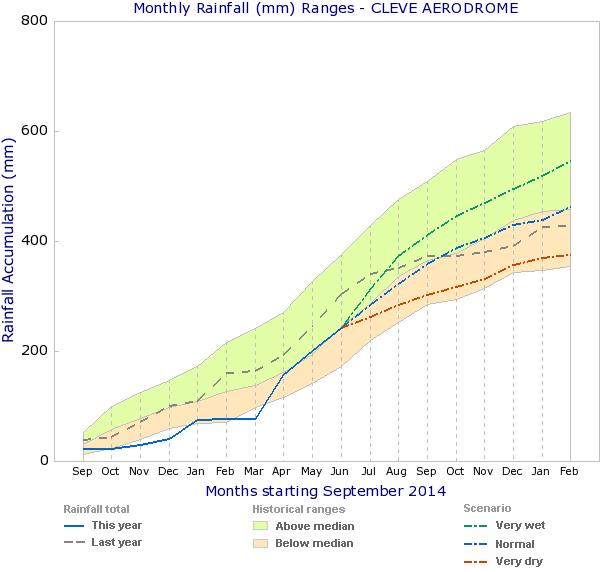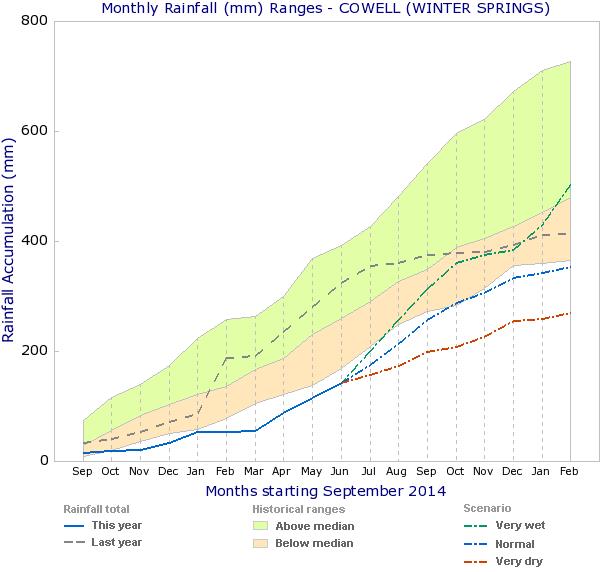Practical production risk management matching inputs with seasonal outlook
Author: Kate Burke (Think Agri Pty Ltd) | Date: 21 Aug 2015
Take home messages
- Judge the season’s potential by monitoring what has happened in the season so far and explore the possibilities for the rest of the season to generate production scenarios.
- Continually review a range of production scenarios based on a broad range of information.
- Continually review the likelihood of reaching a scenario based on a broad range of information.
- Base operational decisions on the most likely range of outcomes.
- There is a wide range of commercial and publically available tools to suit the range of different thinking and learning styles that help users analyse different scenarios.
- Regardless of the specific tools used, the broad strategy described is applicable to all soil types and climate zones and can be particularly profitable if applied habitually.
Background
The reliability and availability of resources to help manage seasonal risk and uncertainty have improved markedly in the last five years. However, human factors often get in the way of making decisions that would lead to the best financial outcome. This paper presents a framework for assessing yield and whole farm production scenarios to assist decision-making.
What’s at stake?
Under- or over-estimating yield potential results in an enterprise not realising income in high yield potential years, or over spending in low yield potential years.
In a favourable yield potential situation, an extra $125 million in wheat income could be generated on the Eyre Peninsula (EP) if yield was improved by 0.5 t/ha across the region. With wheat areas typically 2,000 to 5,000 hectares, that’s $250,000 to $625,000 per farm, assuming a wheat price of $250/tonne. It is likely that grain yield and income was left in EP paddocks as evidenced by low grain protein at harvest.
Time and energy spent by growers and advisers on understanding a season’s true potential could have a massive impact on the financial outcome.
Yield potential scenario analysis
The potential of the season is governed by what has happened up to now and what may happen in the future. Monitoring what has happened up to now and combining that with what may happen in the coming months provides a framework to judge season potential and aid decision making. Regional variation, such as that described in Figure 1 and Figure 2, illustrates the danger of generalising or guessing expected rainfall and the importance of monitoring the actual situation for your farm or region.

Figure 1: Rainfall relative to mean for Australia from November 2014 to end July 2015.


Figure 2: Rainfall from September 2014 to June 2015 and possible outcomes for 2015 compared to the previous season for Cleve and Cowell. (BOM 2015)
Establishing a baseline from your historical data
Reviewing grain protein achievement as part of the annual planning process is a broad indicator of yield performance relative to potential. A history of low protein wheat production indicates that yield is N limited. Paddocks or zones producing wheat with protein less than 11 per cent are highly likely to be N responsive (McDonald and Hooper 2013). Consistently high protein production (> 13 per cent) and high screenings can indicate that nitrogen is not yield-limiting, but that some other factors could be at play in limiting yield. The big four yield determinates of reaching water-limited yield potential in dryland cropping (if pests, weeds and disease aren’t limiting) are usually out of season weed control, time of sowing, nitrogen and varietal choice.
Estimating production scenarios
Allocating time and energy to this process can produce great returns for very little investment. We can’t predict the future, but we can explore the possibilities by understanding the current situation and developing scenarios for the future.
roduction scenario analysis
- Estimate or measure starting soil water and use growing season rainfall to date.
- Look at low, medium and high rainfall options going forward.
- Calculate yields based on Water Use Efficiency (WUE) using one of the tools mentioned in this paper.
- Look at your crops and use common sense to check the scenarios.
- Consider the effects of temperature on yield and grain quality.
- Repeat after significant rainfall events or on a fortnightly basis.
Resources for estimating soil water and growing season rainfall (what’s happened up to now)
- Rainfall records from previous November onwards.
- Qualitative measures - how good was summer weed control on each paddock?
- An understanding of where rainfall sits relative to the average, by using tools such as CliMate or Bureau of Meteorology (BOM) rainfall range.
- Rainfall deciles for the months going forward (Rainman® streamflow or BOM data).
- Measuring soil water at the start of the season and modelling on Yield Prophet®.
- Live moisture modelling using probes such as Sentek.
- Sticking a steel 'push probe' into the ground (to assess the depth of moist soil) works pretty well too!
Approaches to estimating yield potential (what might happen) include:
- French Schultz style WUE calculations.
- Fit for purpose decision support tools such as Yield Prophet®, PYCal, iYield on iPaddock, ProductionWise®, Yield and N calculators.
- Regional estimations provided by a public agency, grower group or agronomy service.
- Historical yields from different types of seasons (the human yield simulator).
The aim is to have a range of yields depending on how the season progresses. Ideally, estimating scenarios works best on a paddock-by-paddock basis, but whole crop view is better than no view at all.
Estimating the likelihood of reaching a scenario (what might happen)
Now we have the production scenarios, what is the likelihood of achieving them?
- Understand where the season is currently at for you. Are you sitting above, below or on average? This is the most important step. CliMate or BOM rainfall range or Yield Prophet/Agricultural Production Systems Simulator (APSIM) decile graphs are great tools to help you determine this. Beware of subtle variations within regions.
- Understand the climate drivers for the current season that are applicable to your region (climatekelpie.com.au).
- Look at a range of forecasts and models.
- Consensus within the majority of models is a strong indicator.
- If there is no consensus, then the outcome is less certain.
- Some models are more accurate than others. It helps to know the more reliable ones.
- Some short term forecasts are more accurate than others. Again, look for consensus.
- It is then possible to narrow down the possible range of yield outcomes.
Useful tools include the BOM website, Victorian DEDJTR reports and summaries, Climatedogs for basic information, Australian Export Grains Innovation Centre reports and the Climate Kelpie website.
Turning information into action and income
- Average outcome likely:
- Is there enough N to get you there?
- Any marketing/hedging opportunities?
- Confidence to protect yield potential when making fungicide decisions?
- Below average outcome possible, but not certain:
- Defer N until season pans out further.
- Minimise expenditure without restricting yield potential.
- Consider business needs if worst-case scenario eventuates.
- Above average outcome likely:
- Review N and top up.
- Marketing/hedging opportunities.
- Harvest planning and logistics.
- Protect yield potential.
Nitrogen decisions
Two areas for improvement in N decision-making that could reap major rewards across the industry are:
- Reviewing production scenarios to ensure the target yield is realistic as described pteviously.
- More emphasis on deep N soil testing.
- Soil sampling is a turnoff, but the rewards are worth the hassle.
- Crop history is a useful indicator, but within and between field variation is significant.
- The financial risk of getting it wrong is too high to ignore.
Conclusion
Current yield potential is governed by what has happened so far and what may happen for the rest of the season. Monitoring seasonal rainfall and soil moisture to date enables you to gauge what has happened so far. Understanding climate drivers and seasonal outlooks helps assess seasonal possibilities. Making yield scenario analysis a habit tightens up decision-making and reduces risk. It will not be exactly right, but it is better than getting caught up in populist optimism when it rains and populist pessimism when it’s been dry for a while.
Good luck.
References and Resources
- McDonald, G and Hooper P (2013) Nitrogen decision - Guidelines and rules of thumb
- BOM rainfall ranges
- Yield Gap Australia
- Climate Kelpie
- Australian CliMate
- Yield Prophet
- AEGIC soil moisture maps
- BOM climate and past weather
Contact details
Kate Burke
0418 188 565
thinkagri@icloud.com
Was this page helpful?
YOUR FEEDBACK
